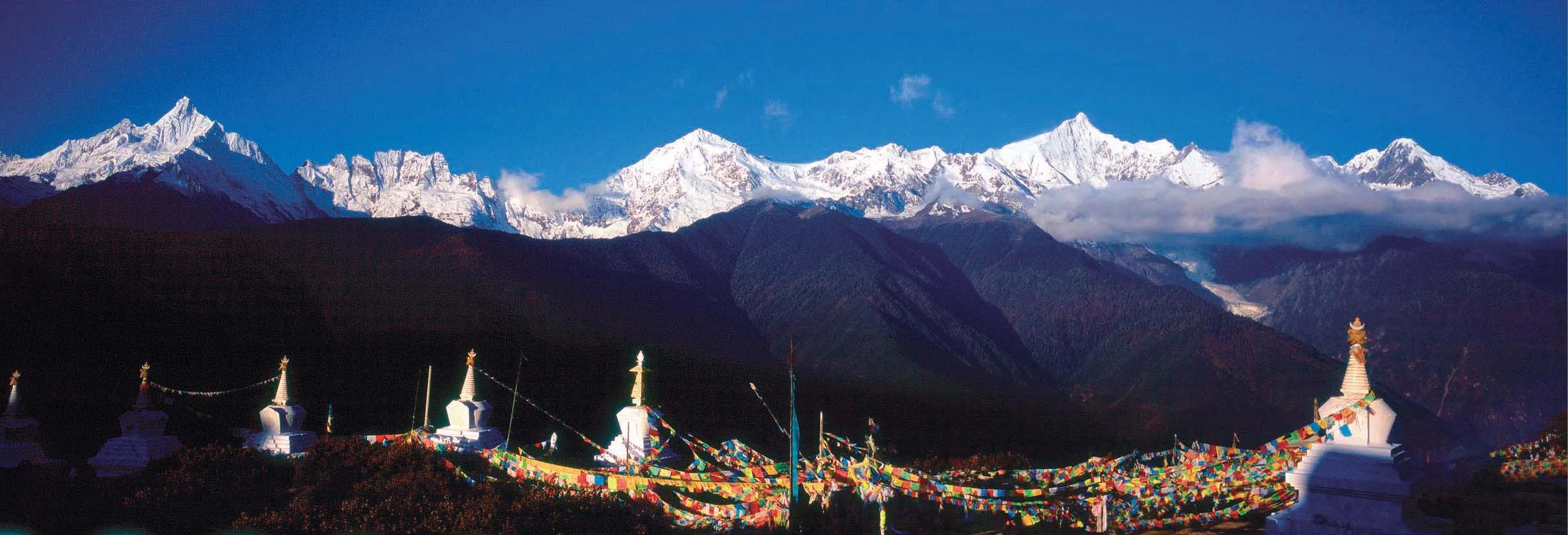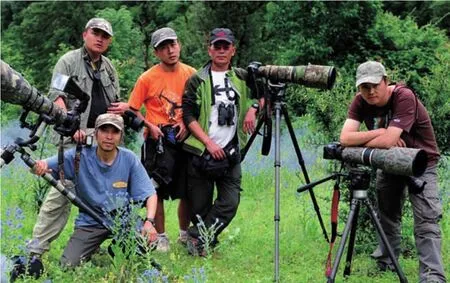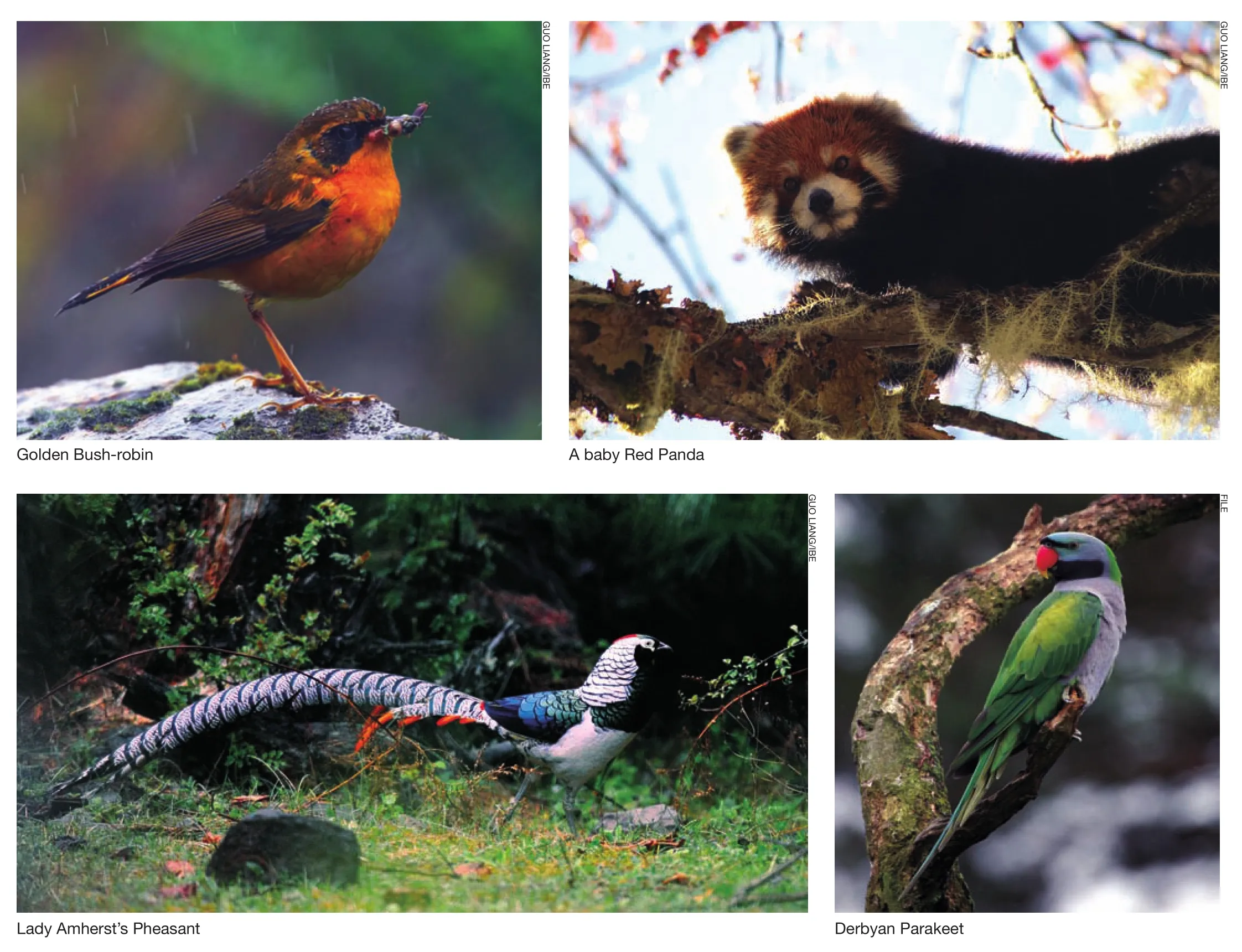Infinite Wonder
2012-10-16WildlifephotographerscapturebiodiversityintheMeiliSnowMountainByYuYan
Wildlife photographers capture biodiversity in the Meili Snow Mountain By Yu Yan
Infinite Wonder
Wildlife photographers capture biodiversity in the Meili Snow Mountain By Yu Yan

The Meili Snow Mountain, the highest mountain in southwest China’s Yunnan Province, boasts numerous snow-clad ridges and peaks and is rich in biodiversity
Imaging biodiversity surveys are currently gaining popularity in China. A group of innovative Chinese photographers are dedicated to recording biodiversity with pictures and videos. They conduct biodiversity investigations, assessments and monitoring through vivid images instead of dull scientific reports, making it easier to communicate to the general public the importance of nature conservation.
“We are not scientists, but a group of people with a strong interest in biology and with a good mastery of photography,” said Peng Jiansheng with a modest smile, while sharing his experience of imaging biodiversity in the Meili Snow Mountain, southwest China’s Yunnan Province, at a salon in Beijing on January 8.
Peng is a senior photographer from Imaging Biodiversity Expedition Institute(IBE), a Beijing-based social enterprise engaged in imaging biodiversity surveys and nature conservation-related products.
The Meili survey, sponsored by the Nature Conservancy (TNC), the Administrative Bureau of Meili Snow Mountain National Park and the Euro-China Biodiversity Programme,produced numerous pictures of many species,including birds, beasts and plants.
Based on the results, the Chinese National Geography Press published theField Guide to the Wildlife of Meili Snow Mountain National Parkin April 2011. It was China’s fi rst nature observation manual in three languages:Chinese, English and Tibetan.
Mountain life
“Of all 20 surveys we conducted, the one to the Meili Snow Mountain was the most fruitful,” said Guo Liang, another IBE biophotographer who worked on the same project.
Due to the unique geological and climate conditions, the snow-capped mountain is rich in biodiversity. In order to get a complete survey, IBE went to the mountain four times in each of the four seasons between 2009 and 2010.
“We conducted the survey in the area from 2,700-meter altitude to 4,200-meter altitude in the mountain, which is covered with dense primeval forests, lakes and high mountain meadows,” said Peng.
Despite the tremendous natural beauty,the work was rather dif fi cult.
“The biggest difficulty is how to find the wildlife and we have to be very patient looking for and waiting for them,” he said.
“When I took the picture of the Lady Amherst’s Pheasant, it rained for a whole night. It was freezing cold on the mountain.We almost despaired and then it came,” said Peng, his eyes shining. “We hid in a tent with windows in four directions to take the picture.”
To take pictures of rare animals, the survey team often looks for them through analyzing their feces, feathers and trails. The hiding tent is one of the most frequently used techniques.They often went into the tent at dawn and hid in it until dark, waiting for animals to pass by.
“If we were lucky, we could take pictures of several animals a day. But when we were not lucky, not a single animal would come near for a whole day,” said Peng.
“To take this picture, we spent quite some time and energy,” he said, pointing to a picture of a Derbyan Parakeet on the screen.
In the picture is an amazingly big group of Derbyan Parakeets fl ying in the blue sky.Due to the damage of its habitat, the number of this beautiful bird has declined sharply in China. Such a big group is rarely seen now.
“The bird loves eating pine nuts, so we hid in the pinewood waiting for them. But they are very smart. While the bird fl ock eats pine nuts in the wood, they leave two guards in the air. Once any danger emerges, the guards will immediately sound the alarm and the flock will fl y away like a cloud,” said Peng.
Sometimes, unexpected joys can emerge.Once on the mountain, the team was on the way to look for black bear and sambar. But when they got to the destination, they found the pool had already dried up, which meant none of those animals would come. However,on their way back, they came across two red pandas, extremely rare animals.
Many challenges
In addition to the difficulties in finding the animals, there are other challenges as well.
As a man suffering from chronic back problems, Peng endured huge pain during the work. However, it never stopped his passion for this job.
“It was very cold on the snow mountain and we had to wear a lot of clothes. While we took pictures, we had to kneel down on the ground from time to time. Several days passed and my back hurt badly,” said Peng.
Passion, patience and persistence have proven very fruitful.
In November 2010, an IBE survey team finally took a photo of a Red Goral (a small, goat-like animal), a fi rst-class national protected animal of China, in the soft sunset after six days’ waiting.
“In addition to patience, to take pictures in nature requires photographers to have sharp eyes,” said Peng. “They should be able to catch the animal from a confused mass or a dark environment.”
Usually, sharp eyes are ensured by sound biological knowledge. “To catch pictures of the wildlife, we have to know them at first glance,” said Guo. “Each IBE photographer is an expert of a certain fi eld, such as insects,beasts and birds.”
Guo, a devoted bird photographer, often walks cautiously three or four steps in the wood, stops and looks around, and then squats down for minutes to watch and take photos of the birds.
“To tell the species of a bird, you need to observe its size, action and fl ying motion.Also, you must carefully observe the colors of its body and feather, and listen to its calls,”Guo said.
On the sideline of the survey, the team members also provide training for local residents on the mountain. They encouraged local people to participate in the survey and taught them to take pictures.
The forest rangers patrol the mountain every day. With a tiny camera in hand, they can catch pictures of rare animals. These pictures can be very precious, said Peng.

IN NATURE: Peng Jiansheng (second right) and Guo Liang(second left) with other members of the IBE survey team in the Meili Snow Mountain in 2009

Peng, together with a group of nature photographers interested in nature conservation,established IBE in 2008. IBE has been devoted to recording, displaying and protecting China’s bio-diversity through scienti fi c means.
Do it my way
Previous bio-diversity surveys were dull scientific reports filled with figures, which makes imaging bio-diversity surveys a popular alternative, said Peng.
While traditional biodiversity surveys are based on scientists’ observations or specimen collection, IBE surveys focus on recording them through pictures or videos. Each picture has GPS geo-information on it.
Each IBE survey is completed through collaborative work of a well-organized team.The team will consist of photographers and related experts with rich outdoor experience and biology expertise.
So far, IBE has carried out 20 surveys in 11 regions of China. Through these surveys, it has recorded close to 6,500 species, taken 250,000 pictures, and made 1,200 minutes of videos.
Social function
“Recording biodiversity through images is not only objective, but also vivid, lively and easy to spread,” said Xu Jian, head of IBE. “It can dramatically strengthen the public’s understanding of nature. Thus, this is signi fi cant for nature protection.”
China’s biodiversity ranks fifth in the world, but such a precious treasure is not paid enough attention to.
“For some rare species, we don’t even have a single picture,” said Xu. “In the past three decades of rapid economic development in China, some species have disappeared before we know them, not to mention protecting them.”
Image recording is the most fundamental work in this sense. Their works not only have aesthetic value, but also contain rich scienti fi c information and data.
“Only when we know the status of a species, can we be clear about how to protect it,” said Xu.
While bringing back survey results to the city, scientists and the media, IBE usually submits a report with suggestions on protecting these species to the local departments of forestry or environmental protection.
In addition to many non-pro fi t projects they conducted to promote biodiversity conservation,IBE also holds nature photography training courses for the public, organizes summer camps for high school students, and recruits volunteers to participate in fi eld investigations.
